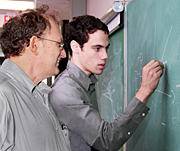- Number 323 |
- October 25, 2010
Taking a spin

PPPL's Nathaniel Fisch (left)
and graduate student Abraham
Fetterman at the chalkboard.
New technology developed at DOE's Princeton Plasma Physics Laboratory might improve the performance of the plasma centrifuge, a faster and more efficient alternative to the gas centrifuges used in enriching uranium for nuclear fuel.
"What makes the plasma centrifuge so effective is that almost unlimited rotation — or spinning — speeds can be reached within the device," explained Abraham Fetterman, a graduate student at PPPL who developed the technology with Princeton University Professor Nathaniel Fisch. This is because the plasma, a gas in which ions and electrons are not bound together, may be contained using a magnetic field rather than a metal cylinder. Magnetic field lines are not subject to the centrifugal force that can bend or break a metal cylinder at high rotation speeds.
While much higher rotation speeds are possible in theory, plasma centrifuges have faced a speed limit because the rotation was produced by parts in contact with the plasma. "The invention should remove this limit because the rotation is created using radio waves launched by an antenna outside the plasma," said Fetterman. The radio waves interact with ions in the plasma in a way that pushes them forward to produce rotation. Fetterman and Fisch hope that the theory will soon be confirmed by experiments.
A related invention by Fetterman and Fisch may be used to separate very light elements in a mixture from very heavy ones. This may be used to reduce the amount of high level nuclear waste, as the heaviest 25 percent of nuclear waste contains 99.9 percent of the radioactivity. If the waste could be efficiently separated, only the heavier fraction would require long-term geological storage, which would substantially reduce the load on any such facilities.
"What we were really pursuing, and continuing to pursue with vigor, is the use of these separation effects not for enriching uranium, but for making a controlled nuclear fusion plasma device. Controlled nuclear fusion, the essentially non-proliferative and safer way of tapping nuclear energy, is of course much more difficult than nuclear fission, but it is PPPL's passion," Fisch said. "The effect in our nuclear fusion work common to our suggestions for a plasma centrifuge is the fascinating way in which plasma waves can be used to cool and remove hot trapped particles while making hotter the remaining particles. But part of our job at PPPL is to recognize spinoff applications to other technologies."
Fisch and Fetterman recently disclosed the centrifuge inventions as part of the patent process.—Raphael RosenSubmitted by DOE's Princeton Plasma Physics Laboratory
